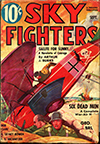Eugene M. Frandzen painted the covers of Sky Fighters from its first issue in 1932 until he moved on from the pulps in 1939. At this point in the run, the covers were about the planes featured on the cover more than the story depicted. On the September 1937 cover, It’s the immortal Fokker D7!
The Ships on the Cover
 THE one type of plane most talked of when the German air service of World War times is mentioned, is the Fokker. And the outstanding plane of the Fokker line was the D7. Anthony Fokker, a Dutchman, tried to interest the Allies in his early efforts in plane building but met with such stubborn sales resistance that when war clouds formed over Europe and the German government showed it meant real business in buying Fokker planes he took up residence in Germany and promptly started to grind out fighting ships.
THE one type of plane most talked of when the German air service of World War times is mentioned, is the Fokker. And the outstanding plane of the Fokker line was the D7. Anthony Fokker, a Dutchman, tried to interest the Allies in his early efforts in plane building but met with such stubborn sales resistance that when war clouds formed over Europe and the German government showed it meant real business in buying Fokker planes he took up residence in Germany and promptly started to grind out fighting ships.
From the start his planes were outstanding. Those first monoplanes of his were flimsy many-wired braced things but they had stability, a characteristic which was lacking in most other types.
First Synchronized Machine-Gun
It was on an early Fokker monoplane that the first synchronized machine-gun appeared. This gun all but blasted the Allies from the skies.

As time progressed, so did Fokker planes. He switched to biplanes. Out of these came the D7, the most dreaded plane the Allies had to contend with.
It had no interplane bracing wires. The only external bracing wires were a pair crossed under the nose on the undercarriage.
On lack of interstrut bracing there goes an interesting side story. German flyers, on seeing no wires on the Fokker D7, threw up their hands in horror and refused to fly the darned things.
“It can’t be done,†they said even as they saw Fokker himself putting the new D7 through a series of difficult maneuvers.
A Fine Flying Steed
Fokker was not stumped. He yanked the D7s back into his assembly plant and had wire braces installed. Out they came again for tests. The German Aces took them up and gave them the works. They came down grinning with appreciation for a fine steed which could outfly any German ship in the skies. After Fokker had his ship in mass production he yanked the wires off all the D7s and said, “There, without those wires which are just dummies, you’ll get a couple of extra miles per hour.†They believed him and the real Fokker D7 was launched to do more damage to the Allies than any oilier ship.
The Squadron of Death
Another trick construction stunt on the Fokker was the welding in the joints of the fuselage. They did this welding in such a manner that it was real mass production done cheaply. After the joints were welded the frame looked as though it had been in a wreck, it was so out of shape. The welders merely hammered it back into alignment in a few minutes and it was ready for the riggers. It took our own engineers nearly two years after the war was over to find out how the Germans had done the stunt.
Many German squadrons painted their ships gaudy colors, put decorations on them and even pictures. One squadron of Fokker D7s called themselves the Squadron of Death. And on the fuselage of each plane was painted a skull and crossbones. They had such faith in this death dealing ship that they flaunted their gruesome insignia in the faces of the enemy as they drove them out of the sky. But war is a business, and like peacetime business a competitor’s product must be equalled or bettered or you go to the wall. The Allies didn’t intend going to the wall. True, from behind the eight ball things looked bad, but they had arched their backs and in a very few months the Fokker D7 was fighting for its life.
On the cover two Boche pilots tangled with a single Nieuport 28 C.1. Both Fokkers had skull and crossbones insignia on their flat fuselages. But it’s superior ships and superior flying that chalks up the score.

The first Fokker staggered in its tracks as the guns of the Nieuport blasted slugs into it. A puff of black smoke and down it went. The other German pilot stubbornly attacked the Nieuport which proceeded to fly rings around him and chop his ship to pieces. German ground troops fired their rifles up at the wraithlike Nieuport. Then the Fokker gave a sudden lurch, nosed down in a sickening power dive. German ground troops, who had admiringly noted the skull and crossbones, now gasped in horror as the ship went out of control and smashed them into the sides of their own trenches. The Fokker D7 had been equalled!
It had reached its peak. The Allies threw equally fine planes into the skies—but few surpassed the blunt-nosed awkward product of the Dutch inventor, Anthony Fokker.

Sky Fighters, September 1937 by Eugene M. Frandzen
(The Ships on The Cover Page)









